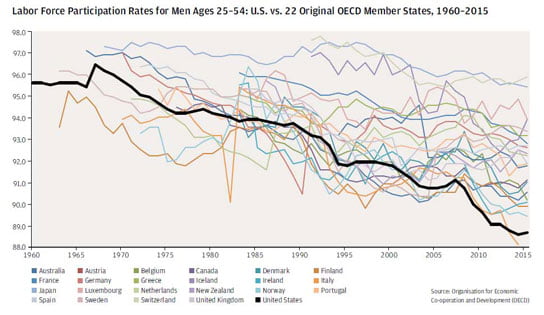
Jamie Dimon, Chairman and CEO of JPMorgan Chase, publishes an annual letter to shareholders. Beginning on Page 32, Dimon provides a deep analysis of the American culture and economy. Dimon locks on to the U.S. workforce participation decline where he notes that we have a serious problem.
Jamie Dimon, Chairman and CEO of JPMorgan Chase, publishes an annual letter to shareholders. Beginning on Page 32, Dimon provides a deep analysis of the American culture and economy. Dimon locks on to the U.S. workforce participation decline where he notes that we have a serious problem.[/caption]Jamie Dimon, Chairman and CEO of JPMorgan Chase, publishes an annual letter to shareholders. If you ever wanted to see deeply into the mind of a banking institution, this is worth 30 minutes of your time. While the self congratulatory banking rhetoric is enough to rankle the liberals in the audience, there’s some good stuff here.
Beginning on Page 32, Dimon provides a deep analysis of American culture and economy. (I’d save the first 31 pages for later.)
“Labor force participation in the United States has gone from 66% to 63% between 2008 and today. Some of the reasons for this decline are understandable and aren’t too worrisome — for example, an aging population. But if you examine the data more closely and focus just on labor force participation for one key segment; i.e., men ages 25-54, you’ll see that we have a serious problem. The chart below shows that in America, the participation rate for that cohort has gone from 96% in 1968 to a little over 88% today. This is way below labor force participation in almost every other developed nation.
“If the work participation rate for this group went back to just 93% — the current average for the other developed nations — approximately 10 million more people would be working in the United States. Some other highly disturbing facts include: Fifty-seven percent of these non-working males are on disability, and fully 71% of today’s youth (ages 17–24) are ineligible for the military due to a lack of proper education (basic reading or writing skills) or health issues (often obesity or diabetes).”
And:
“Many high schools and vocational schools do not provide the education our students need — the goal should be to graduate and get a decent job. We should be ringing the national alarm bell that inner city schools are failing our children — often minorities and children from lower income households. In many inner city schools, fewer than 60% of students graduate, and many of those who do graduate are not prepared for employment. We are creating generations of citizens who will never have a chance in this land of dreams and opportunity. Unfortunately, it’s self-perpetuating, and we all pay the price. The subpar academic outcomes of America’s minority and low-income children resulted in yearly GDP losses of trillions of dollars, according to McKinsey & Company.”
And:
“Low job growth, a lack of opportunity for many, declining wages, students and low wage workers being left behind, economic and job uncertainty, high healthcare costs and growing income inequality all have created deep frustration. It is understandable why so many are angry at the leaders of America’s institutions, including businesses, schools and governments – they are right to expect us to do a better job. Collectively, we are the ones responsible. Additionally, this can understandably lead to disenchantment with trade, globalization and even our free enterprise system, which for so many people seems not to have worked.”
It’s a healthy look at the underlying issues in our economic circumstances. Anyone who works in HR ought to have an articulate opinion, one way or another, about the issues laid out in the last 15 pages of the report.
Left out of the discussion, for some reason, is the whirlwind of damage and opportunity wrought by technology. Virtually every job is being digested by a technology parasite while workers execute the work. Staying on top of the tech wave requires surfing skills and the opportunity to refine new ones. This often (until you lose the workforce) looks like unnecessary investment.
Take a gander at the letter. I’d love t know what you think.












